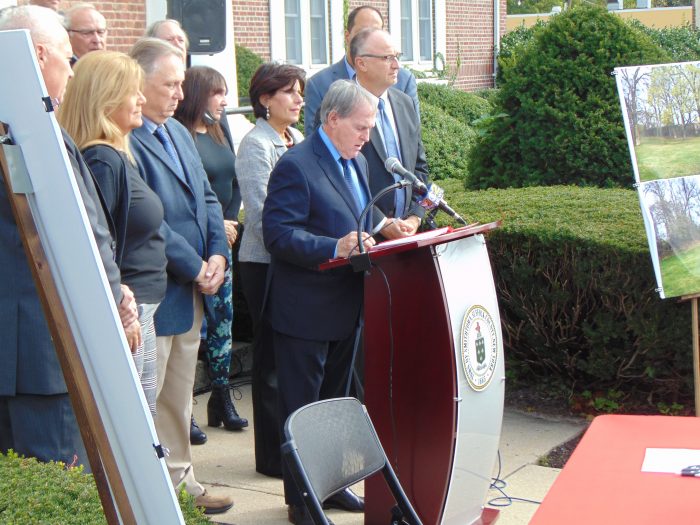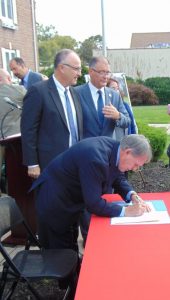Elected officials and community leaders join forces in support of sewer plan for Smithtown

The steps of Smithtown’s Town Hall were packed the morning of Oct. 12 as elected town, county and state officials, as well as community leaders from the hamlets of Smithtown and Kings Park, were on hand to talk about sewers and make a plea to the state’s new governor.

The group signed a letter to Gov. Kathy Hochul (D) asking her to help to secure a path to a sewer infrastructure in the town. Those speaking at the press conference spoke about the lack of a sewer system in the town having a negative impact on economic growth and the health of waterways, especially Smithtown Bay.
Smithtown Supervisor Ed Wehrheim (R) said the group has worked “tirelessly for years to make this project come to fruition.”
“For nearly 50 years, the goal of providing sewers for the Smithtown business district had seemed out of reach, resulting in vacant storefronts in the downtown area and continued discharges of untreated wastewater into our environment,” the supervisor said. “Now, at long last, a clear solution has been identified. A victory is in sight for both of these business districts. This is truly a historic day for the Town of Smithtown and the future of our town.”
A $20 million grant was announced in 2017 by the state that would have helped bring sewers to the town’s business districts. According to Wehrheim, a lack of a site for a system stalled the project. Recently, the Smithtown Sewer Working Group, which includes local business and community leaders, has worked for 18 months to identify a site for a recharge facility and named a parcel owned by the state Office of Mental Health at the former Kings Park Psychiatric Center as a possible location. The hopes are to connect Main Street, Smithtown and the Kings Park business district to a system.
The plan would include removing an abandoned building. The facility would use only 2 acres of 17 of the land.
Smithtown United President Timothy Small called the working group an “example of your government and community working together for solutions.”
He added that under current conditions the sewer recharging facility would lead to an 87% reduction of the amount of nitrogen dumped into groundwater which eventually makes its way to the Nissequogue River. He said after a complete “downtown buildout consistent with the draft Smithtown Master Plan” the nitrogen reduction would be 71%.
Michael Kaufman, a member of the civic group Smithtown United and the town’s working group, said hooking up central business districts to a sewer system is the “gold standard for solutions” to avoid environmental issues such as nitrogen from septic waste being released to nearby bodies of water. He added that a recent water quality report showed that Smithtown Bay is one of the most oxygen-deprived areas east of New York City. This deprivation means that it’s difficult for fish to survive.
“That’s why no one can really go fishing in Smithtown Bay anymore,” he said.
Kaufman said the damage is identical to issues the area had in the 1990s.
“We know what the source is, and we also know how it gets out into the water,” he said. “Basically, [it goes] west right into the Nissequogue River and then just flows down the river and then it goes into the Smithtown Bay where it unfortunately stays for a couple of days.”
Among those representing chamber and civic groups was Kings Park Chamber of Commerce President Tony Tanzi who called the proposed facility “an absolutely wonderful thing.” He said he felt it helped the community as a whole for many reasons, listing qualities such as a viable downtown, lessening pollution of rivers and protecting open space. He added from the chamber of commerce’s perspective it could restore economic viability to the downtown.
“We’ve got the ability to preserve 15 acres of open space in perpetuity,” Tanzi said. “You’ve got the ability to protect our drinking water. You’ve got the ability to protect the Nissequogue River and the Long Island Sound and preserve our drinking water for future generations, which is really what we’re all here trying to do.”






